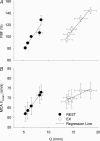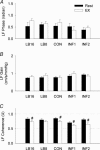The effect of changes in cardiac output on middle cerebral artery mean blood velocity at rest and during exercise
- PMID: 16210355
- PMCID: PMC1464249
- DOI: 10.1113/jphysiol.2005.095836
The effect of changes in cardiac output on middle cerebral artery mean blood velocity at rest and during exercise
Abstract
We examined the relationship between changes in cardiac output and middle cerebral artery mean blood velocity (MCA V(mean)) in seven healthy volunteer men at rest and during 50% maximal oxygen uptake steady-state submaximal cycling exercise. Reductions in were accomplished using lower body negative pressure (LBNP), while increases in were accomplished using infusions of 25% human serum albumin. Heart rate (HR), arterial blood pressure and MCA V(mean) were continuously recorded. At each stage of LBNP and albumin infusion was measured using an acetylene rebreathing technique. Arterial blood samples were analysed for partial pressure of carbon dioxide tension (P(a,CO2). During exercise HR and were increased above rest (P < 0.001), while neither MCA V(mean) nor P(a,CO2) was altered (P > 0.05). The MCA V(mean) and were linearly related at rest (P < 0.001) and during exercise (P = 0.035). The slope of the regression relationship between MCA V(mean) and at rest was greater (P = 0.035) than during exercise. In addition, the phase and gain between MCA V(mean) and mean arterial pressure in the low frequency range were not altered from rest to exercise indicating that the cerebral autoregulation was maintained. These data suggest that the associated with the changes in central blood volume influence the MCA V(mean) at rest and during exercise and its regulation is independent of cerebral autoregulation. It appears that the exercise induced sympathoexcitation and the change in the distribution of between the cerebral and the systemic circulation modifies the relationship between MCA V(mean) and .
Figures

 (in l min−1) and percentage FBF (where control FBF at rest was equal to 100%) was linear; Rest, FBF (%) = 11.9 ×
(in l min−1) and percentage FBF (where control FBF at rest was equal to 100%) was linear; Rest, FBF (%) = 11.9 × + 19.4, R = 0.93, P = 0.023; Exercise, FBF (%) = 10.0 ×
+ 19.4, R = 0.93, P = 0.023; Exercise, FBF (%) = 10.0 × – 37.3, R = 0.98, P = 0.003. The significant relationship between
– 37.3, R = 0.98, P = 0.003. The significant relationship between  (in l min−1) and MCA Vmean (in cm s−1) was linear; Rest, MCA Vmean = 3.4 ×
(in l min−1) and MCA Vmean (in cm s−1) was linear; Rest, MCA Vmean = 3.4 × + 44.0, R = 0.99, P < 0.001; Exercise, MCA Vmean = 1.2 ×
+ 44.0, R = 0.99, P < 0.001; Exercise, MCA Vmean = 1.2 × + 52.9, R = 0.90, P = 0.035.
+ 52.9, R = 0.90, P = 0.035.
 (A) and between percentage MCA Vmean and
(A) and between percentage MCA Vmean and  (B) for all subjects (means ±
(B) for all subjects (means ± 
Similar articles
-
Dynamic blood pressure control and middle cerebral artery mean blood velocity variability at rest and during exercise in humans.Acta Physiol (Oxf). 2007 Sep;191(1):3-14. doi: 10.1111/j.1748-1716.2007.01708.x. Epub 2007 May 17. Acta Physiol (Oxf). 2007. PMID: 17506866 Clinical Trial.
-
Varying the heart rate response to dynamic exercise in pacemaker-dependent subjects: effects on cardiac output and cerebral blood velocity.Clin Sci (Lond). 2005 Dec;109(6):493-501. doi: 10.1042/CS20050094. Clin Sci (Lond). 2005. PMID: 16038616
-
Effects of changes in central blood volume on carotid-vasomotor baroreflex sensitivity at rest and during exercise.J Appl Physiol (1985). 2006 Jul;101(1):68-75. doi: 10.1152/japplphysiol.01452.2005. Epub 2006 Mar 30. J Appl Physiol (1985). 2006. PMID: 16575020
-
Sympathetic influence on cerebral blood flow and metabolism during exercise in humans.Prog Neurobiol. 2011 Nov;95(3):406-26. doi: 10.1016/j.pneurobio.2011.09.008. Epub 2011 Sep 24. Prog Neurobiol. 2011. PMID: 21963551 Review.
-
Cerebral blood flow and metabolism during exercise.Prog Neurobiol. 2000 Jul;61(4):397-414. doi: 10.1016/s0301-0082(99)00057-x. Prog Neurobiol. 2000. PMID: 10727781 Review.
Cited by
-
Blood pressure regulation IX: cerebral autoregulation under blood pressure challenges.Eur J Appl Physiol. 2014 Mar;114(3):545-59. doi: 10.1007/s00421-013-2667-y. Epub 2013 Jun 5. Eur J Appl Physiol. 2014. PMID: 23737006 Free PMC article. Review.
-
Preserved frontal lobe oxygenation following calcium chloride for treatment of anesthesia-induced hypotension.Front Physiol. 2014 Oct 22;5:407. doi: 10.3389/fphys.2014.00407. eCollection 2014. Front Physiol. 2014. PMID: 25374543 Free PMC article.
-
Dehydration accelerates reductions in cerebral blood flow during prolonged exercise in the heat without compromising brain metabolism.Am J Physiol Heart Circ Physiol. 2015 Nov;309(9):H1598-607. doi: 10.1152/ajpheart.00525.2015. Epub 2015 Sep 14. Am J Physiol Heart Circ Physiol. 2015. PMID: 26371170 Free PMC article.
-
Differential blood flow responses to CO₂ in human internal and external carotid and vertebral arteries.J Physiol. 2012 Jul 15;590(14):3277-90. doi: 10.1113/jphysiol.2012.230425. Epub 2012 Apr 23. J Physiol. 2012. PMID: 22526884 Free PMC article.
-
Contactless Assessment of Cerebral Autoregulation by Photoplethysmographic Imaging at Green Illumination.Front Neurosci. 2019 Nov 13;13:1235. doi: 10.3389/fnins.2019.01235. eCollection 2019. Front Neurosci. 2019. PMID: 31798408 Free PMC article.
References
-
- Brys M, Brown CM, Marthol H, Franta R, Hilz MJ. Dynamic cerebral autoregulation remains stable during physical challenge in healthy persons. Am J Physiol Heart Circ Physiol. 2003;285:H1048–H1054. - PubMed
-
- Busija DW, Heistad DD. Effects of cholinergic nerves on cerebral blood flow in cats. Circ Res. 1981;48:62–69. - PubMed
-
- Collins HL, Augustyniak RA, Ansorge EJ, O'Leary DS. Carotid baroreflex pressor responses at rest and during exercise: cardiac output vs regional vasoconstriction. Am J Physiol Heart Circ Physiol. 2001;280:H642–H648. - PubMed
-
- Dalsgaard MK, Ogoh S, Dawson EA, Yoshiga CC, Quistorff B, Secher NH. Cerebral carbohydrate cost of physical exertion in humans. Am J Physiol Regul Integr Comp Physiol. 2004;287:R534–R540. - PubMed
Publication types
MeSH terms
Substances
Grants and funding
LinkOut - more resources
Full Text Sources
Medical

